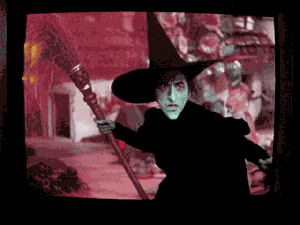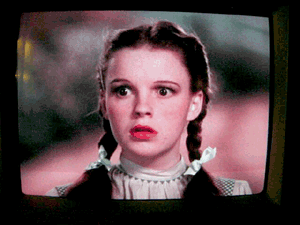What is Two-Color TV?Complementary colors. We're familiar with three-color TV. After all, it's been available since 1951 or so. (At least in the US.) Two-color TV is almost the same thing, only it uses two primary colors. Yes, that's possible! But how could we build full-color images with just two primary colors? Simple. All we need is a TV set that displays two complementary colors. These colors become our primaries, replacing red, blue and green. |

|
Complementary requirements. In television, not just any two complementary colors will suffice. There are rules: First, a nearly equal combination of the two colors must produce white. Second, the two colors must produce natural-looking flesh tones. (That leaves out yellow and blue.) Red-orange and teal are the most desirable pair. Mix exactly half of each and you get white. Red-orange makes realistic flesh tones, while teal makes acceptable (if imperfect) skies and grass. (Teal is a blue-green hue that is slightly more blue than cyan.) A reliable second choice for the two colors is red and cyan. But the formula for white requires unequal quantities, 30 percent red to 70 percent cyan.
|
|
|
Flicker Reduction
|
For field-sequential TV. Of all these advantages, flicker reduction is the most important. Why? Because flicker is the most irritating disadvantage of field sequential TV. Field-sequential TV is the “CBS method” that DLP projectors and 3D games use. In history, Col-R-Tel converters (not the CBS System) were the most prominent field-sequential technology. Cameras that operated on the Col-R-Tel standard journeyed to the moon with Apollo astronauts. (See Moon Col-R-Tel.) For those who haven't read our Col-R-Tel pages: Col-R-Tel was an add-on color wheel and chroma decoder for U.S. monochrome TVs. With Col-R-Tel, a monochrome TV could decode standard color telecasts and display them in full color. Col-R-Tel's main flaw was that it could only display one color at a time. The viewer noticed this effect as flicker. As we'll see, Spectrac, a later converter, solved the flicker problem. In fact, Spectrac proved that two colors could reduce flicker while depicting natural-looking people and scenes. Meanwhile, Spectrac also introduced a novel, two-level scanning belt that replaced the color wheel. Compared to the wheel, the belt was smaller, ran more quietly, and drew less current. |
 Benham 2-color TV displays witch from The Wizard of Oz. Mouse over for
ruby slippers.
Benham 2-color TV displays witch from The Wizard of Oz. Mouse over for
ruby slippers.
|
Go to Page: 1 2 3 4 5 6 7 8 9 Next
Page Directory
On this page...What is Two-Color TV Advantages & Disadvantages Flicker Reduction
On related pages...
Col-R-Tel vs. Spectrac Two-Color TV History TV System Flicker Comparison 2.5-Color TV Gould Television: 3D from the Great Depression Gould 3D: Could It Work? Gould 3D: Camera & Monitor Formulas The Lost Creations of Leslie Gould Spectrac: Color for a Monochrome World
 Cliff Benham's famous, 2-color TV with Dorothy from The Wizard of Oz.
Mouse over for the Scarecrow.
Cliff Benham's famous, 2-color TV with Dorothy from The Wizard of Oz.
Mouse over for the Scarecrow.